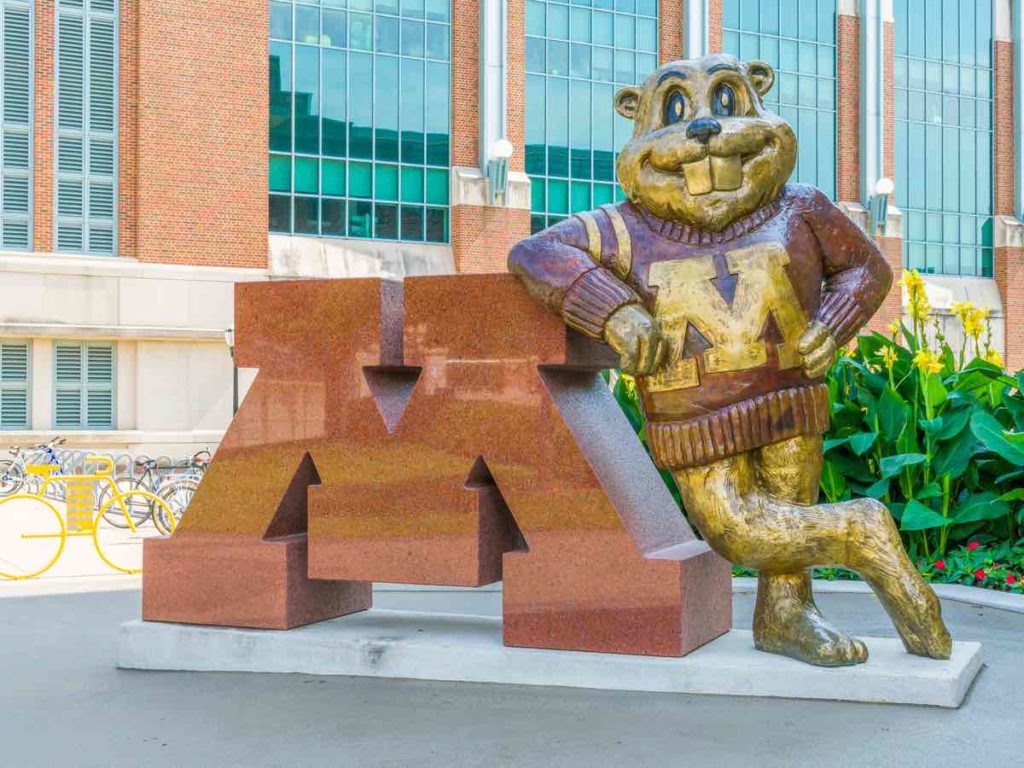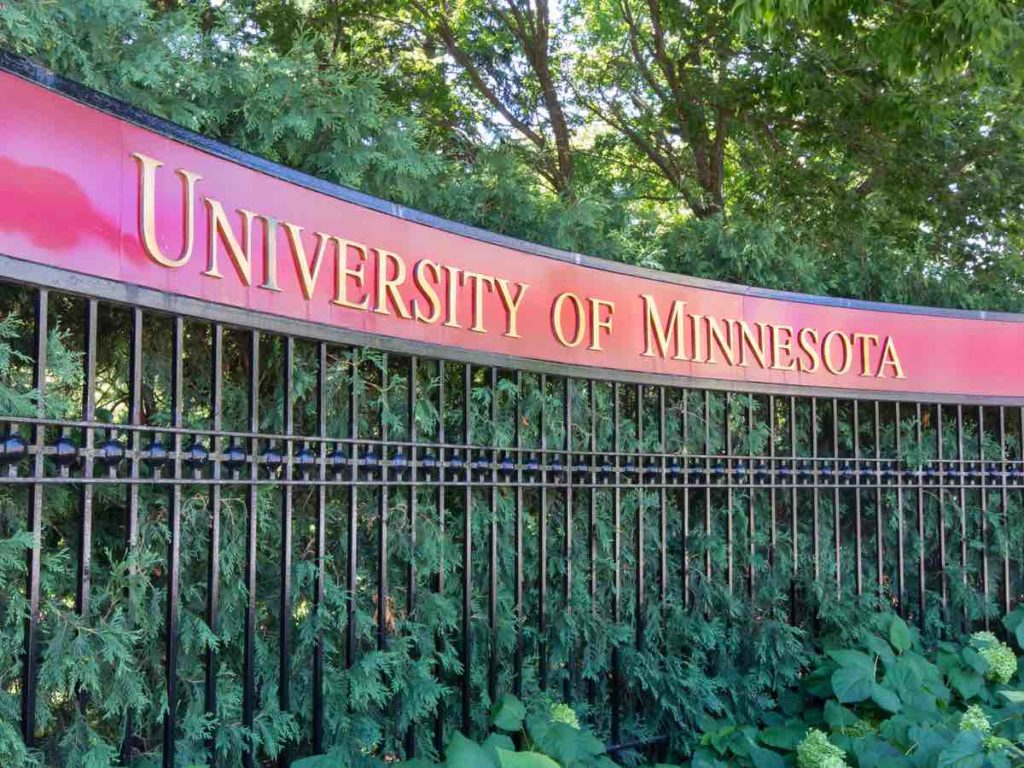Is the University of Minnesota a Good School?
The University of Minnesota (also referred to as U of M or UMN for short) is a public research university.
It is found in 2 different cities in Minnesota, and they are Minneapolis and Saint Paul.
The entire University of Minnesota system has 5 schools, and UMN is the flagship campus. There are 52,376 students going to it, and around 69% are undergrads.
Among the University of Minnesota’s 150 majors, computer science and liberal arts are considered some of the most popular among students.
UMN accepts 73% of all those who apply to it yearly, and it has rolling admissions.
Tuition and fees cost $15,859 for residents, while they amount to $35,099 for non-resident ones.
The institution enjoys these college rankings given to it by US News: #62 in National Universities and #23 in Top Public Schools.
And now, some quick stats about the school:
- Location: Minneapolis, Minnesota
- Founding date: 1851
- Motto: Commune vinculum omnibus artibus (a common bond for all the arts)
- Campus size: 1,204 acres
- Campus type: Urban
- School type: Liberal public land-grant research university
- Reputation: Party school
- Selectivity level: Moderately selective
- Number of majors: 150
- Popular majors: Biology, Computer Science, Economics, Education, Finance, Journalism, Psychology
- Student body: 52,017 (as per Common Data Set 2020 to 2021)
- Students per class: 20 to 29 in most classes
- Student-to-faculty ratio: 17:1
- Retention rate: 93%
- Graduation rate: 78%
- Athletic affiliation: NCAA Division I
- Color: Maroon and gold
- Mascot: Goldy Gopher
- Number of varsity teams: 25
- Sports: Baseball, basketball, cross country, football, golf, gymnastics, hockey, rowing, soccer, softball, swimming and diving, tennis, track and field, volleyball, wrestling
Most of the time, when mentioning the University of Minnesota, we are referring to its flagship school: the University of Minnesota – Twin Cities.
Its other campuses are in Crookston, Duluth, Morris and Rochester.

University of Minnesota Rankings
US News ranks The University of Minnesota #23 in Top Public Schools. Meanwhile, U of M is #1 in the Top Public Universities in Minnesota by Niche.
The University of Minnesota ranks highly consistently. As a result, it’s considered a Public Ivy.
Across the US, there’s no denying that UMN is one of the most well-known and prestigious public institutions.
As a matter of fact, College Simply ranks it #25 in Best Public Colleges in the US.
It’s also #25 in Top Public Universities in America by Niche. On the other hand, U of M is #44 in QS World University Rankings — that’s #177 globally.
In the North Star State, it’s apparent that the University of Minnesota is one of the best institutions for higher education. It’s also one of the largest and most selective.
Let’s take a quick look at the various local rankings of the school by different college rankers:
- #1 in Top Universities in Minnesota (UniRank)
- #1 in Best Colleges in Minnesota (University Magazine)
- #2 in Minnesota’s Best Colleges and Universities (Academic Influence)
- #3 in Best Colleges in Minnesota (College Simply)
- #3 in Best Colleges in Minnesota (Niche)
- #4 in Best Colleges in Minnesota (College Factual)
- #9 in the Midwest (Forbes)
What is the University of Minnesota Known For?
The University of Minnesota is known for being a large school. As a matter of fact, its campus stretches over two major cities: Minneapolis and Saint Paul.
In Minnesota and the US, too, UMN is highly ranked. Because of its academics, selectivity and social life, it’s considered a Public Ivy.
When large colleges and universities in the US are the ones being talked about, chances are the name of the University of Minnesota will pop out of someone’s mouth.
No one can blame the person for it really has a massive 1,204-acre campus, which has an urban setting.
A campus is full of many people, a great place to meet new friends and get yourself out of your shell. being in the lights of Minneapolis gives the U a unique cultural background, and a great place to learn all sorts of things.
Niche.com
Needless to say, it has a large population — as of this writing, U of M is home to 52,017 undergraduate and graduate students.
It also goes without saying that its student body is diverse, which makes it the ideal school for degree-seeking students who would like to get exposed to different cultures, languages, belief systems, etc.
At the University of Minnesota, undergraduates should declare a major no later than the end of their fourth semester of enrollment.
And there are many choices, some of the most popular and highly ranked ones include:
- Biology
- Chemical Engineering
- Computer Engineering
- Computer Science
- Economics
- Education
- Electrical Engineering
- Finance
- Industrial Engineering
- Journalism
- Mathematics
- Mechanical Engineering
- Nursing
- Political Science
- Psychology
Earlier, we mentioned that the UMN campus is located in two cities, which is why its main campus is referred to as the University of Minnesota – Twin Cities.
As a result of this, the things to do and places to visit outside the school grounds are twice as many as at any other institution in the land.
There are shopping centers, spas, restaurants, cafes, bars, museums, art galleries, theaters, orchestra halls, parks and stadiums to visit.
And there’s the 12-day Minnesota State Fair in late August and early September.
Some of the major cities closest to the University of Minnesota campus are:
- Madison
- Milwaukee
- Omaha
- Lincoln
- Chicago
Is UMN a Party School?
Having a big Greek life is one of the reasons why U of M has a lot of parties. In fact, according to a Niche ranking, the school is #1 in Best Greek Life Colleges in Minnesota.
Fraternities and sororities — they are some of the reasons why UMN has a party school reputation.
In addition to on-campus parties courtesy of the school’s Greek life, there are also lots of off-campus revelries.
More often than not, they take place in college bars that come aplenty where there is a large concentration of academic institutions, including Saint Paul and Minneapolis, right where U of M is located.
The vast majority of them offer cheap beer and have nightly specials practically every night of the week.
Another reason why the University of Minnesota has a great party scene is the fact that there are more than 1,000 student clubs and organizations in existence at the school, the majority of which regularly hold programs and events.
At U of MN, having no group to belong to is going to be the least of your concerns.
Schools are Similar to the University of Minnesota
Often, the University of Minnesota is compared with Minnesota State University – Moorhead and Winona State University, both of which are also public institutions located in Minnesota.
Iowa State University, Ohio State University, and the University of Texas at Austin are similar to U of MN.
Adding only one to two reach schools to your college list can spare you from unnecessary frustration.
If you believe that you are what the University of Minnesota is looking for exactly based on your academic and non-academic admissions factors, it’s a great idea to also apply to schools similar to it.
The good news is that there are plenty of UMN-like institutions to choose from. Some of them are public and Minnesota-based, too.
However, there are also those located outside the state that would make for fantastic additions to your college list, public and private alike.
Without further ado, let’s look at some schools similar to the University of Minnesota:
- Iowa State University. Founded in 1858, Iowa State University is the largest institution in Iowa. It’s also classified as a Carnegie Foundation Doctoral and Research University.
- Minnesota State University – Moorhead. US News ranks Minnesota State University – Moorhead #24 in Top Public Schools. A party school, its most popular majors include Business, Education and Psychology.
- Northwestern College. A highly ranked Christian school located in Orange City, Iowa, Northwestern College has an acceptance rate of 70%, a retention rate of 83%, and a graduation rate of 65%.
- Ohio State University. Considered a Public Ivy, Ohio State University is home to the leader for healthcare and medical research in central Ohio, the Wexner Medical Center.
- St. Olaf College. A private liberal arts college in Northfield, Minnesota with a student population of 2,988, St. Olaf College was founded by a group of Norwegian-American pastors and farmers in 1874.
- University of Florida. When it comes to sports, the University of Florida is one of the best. In fact, it’s #1 in Best College Athletics in America and #1 in Best Colleges for Student Athletes in Florida by Niche.
- University of Texas at Austin. Students who like to earn a degree from a school with a massive, urban campus and a large, diverse student body will find the University of Texas at Austin a perfect fit.
- University of Wisconsin – Madison. Other than being the flagship school of the University of Wisconsin System, the University of Wisconsin is also the official state university of Wisconsin.
Acceptance Rate at the U of Minnesota
The University of Minnesota has an acceptance rate of 57%. Since more than half of all applicants get accepted, the school is moderately selective.
Among Minnesota’s various colleges and universities, UMN is one of the most selective. The lowest acceptance rate by any school in the state is 19%.
Many four-year institutions in Minnesota have 100% acceptance rates. Only a very few of them accept less than half of all applicants: Carleton College, Macalester College and St. Olaf College.
If the University of Minnesota is your dream school, rejoice for it accepts the majority of applicants.
However, it doesn’t mean that you can have a terrible application and still expect to get an offer to enroll.
To be one of the 57% of applicants who receive acceptance letters, you will have to impress the school’s admissions officers with your application’s academic and non-academic factors.
UMN, after all, is a flagship school and has one of the lowest acceptance rates in the state of Minnesota.
In order to gain admission into a competitive school like it, your application has to be competitive, too.
Here are some of the most selective colleges and universities in Minnesota, arranged by acceptance rate:
| NAME | LOCATION | ACCEPTANCE RATE |
| Carleton College | Northfield | 19% |
| Macalester College | Saint Paul | 32% |
| St. Olaf College | Northfield | 48% |
| Crown College | Saint Bonifacius | 50% |
| Metropolitan State University | Saint Paul | 56% |
| University of Minnesota – Twin Cities | Minneapolis | 57% |
| University of Minnesota – Morris | Morris | 57% |
| Minneapolis College of Art and Design | Minneapolis | 59% |
| University of Minnesota – Rochester | Rochester | 60% |
| Minnesota State University – Mankato | Mankato | 63% |
| Southwest Minnesota State University | Marshall | 64% |
| Bemidji State University | Bemidji | 65% |
| Minnesota State University – Moorhead | Moorhead | 65% |
| McNally Smith College of Music | Saint Paul | 65% |
| St. Catherine University | Saint Paul | 67% |
| Concordia College – Moorhead | Moorhead | 68% |
| Hamline University | Saint Paul | 68% |
| University of Minnesota – Crookston | Crookston | 68% |
| Winona State University | Winona | 68% |
| Gustavus Adolphus College | Saint Peter | 69% |

Getting Into the University of Minnesota
The school offers Early Action. This admission plan is non-binding and comes in a couple of deadlines: November 1 and December 1.
At U of M, admissions decisions can be any of the following: admit, deny, defer and waitlist.
Many graduating high school teens apply Early Decision to their top-choice colleges and universities.
Got the University of Minnesota at the top of your college list? Unfortunately, you cannot apply to it Early Decision.
But the good news is that you can still apply earlier than everybody else as it offers Early Action.
The University of Minnesota is a very large campus. The class size is pretty big as well but you can always go to office hours to get the one on one with professors.
Niche.com
What’s nice about this admission plan is that, unlike Early Decision, it’s non-binding. So, in other words, you can apply to another school even after getting an offer from UMN.
However, the general consensus is that Early Action does not offer the same increased chances of admission as Early Decision.
At U of MN, aspirants can apply Early Action I and Early Action II.
This means that those who miss the first deadline still have one more chance to submit their applications and required materials.
Here are the most important dates to remember if you wish to apply to the University of Minnesota:
| ADMISSION PLAN | DEADLINE | DECISION NOTIFICATION |
| Early Action I | 1-Nov | 31-Jan |
| Early Action II | 1-Dec | 15-Feb |
| Regular Decision | 1-Jan | 31-Mar |
Just because U of M is your top-choice school doesn’t mean you should apply earlier than Regular Decision.
The goal is to receive an acceptance letter.
If you feel that your senior grades or later test scores could help make your application look so much better, then it’s a good idea to skip applying Early Action.
University of Minnesota Cost and Tuition
The estimated cost of attending the University of Minnesota for one year is $29,684 for in-state students. The amount increases by around one and a half for out-of-state students: $49,774. At UMN, around 56% of undergraduates receive some form of aid.
As of this writing, the average tuition and fees at public colleges and universities in the state of Minnesota for residents and non-residents are $6,980 and $8,818, respectively.
This means that attending the University of Minnesota is slightly more expensive than going to most other schools in the North Star State, given that UMN’s tuition and fees are $15,368 for in-state students and $33,958 for out-of-state students.
Especially if you reside outside Minnesota, it’s important to consider these figures.
Related Article: 425 Colleges Charging In-State Tuition for Out-of-State Applicants
Here’s a breakdown of the sticker price of U of M:
| EXPENSES | IN-STATE COSTS | OUT-OF-STATE COSTS |
| Tuition and fees | $15,368 | $33,958 |
| Loan fees | $154 | $154 |
| Books and supplies | $1,000 | $1,000 |
| Room and board | $10,934 | $10,934 |
| Transportation | $228 | $1,728 |
| Miscellaneous | $2,000 | $2,000 |
| TOTAL | $29,684 | $49,774 |
To help bring down the cost of earning a degree from the University of Minnesota for both in-state and out-of-state students, the school gives all sorts of financial aid to eligible students.
As mentioned earlier, about 56% of undergraduate students get some type of aid. Based on online data, the average amount each one gets is $9,253.
University of Minnesota ROI
The amount of annual salaries the University of Minnesota alumni members make varies according to many factors, including the major.
Generally speaking, the initial salaries of U of MN graduates average $44,700 a year. Ten years after initial enrollment, the amount increases to about $58,200 a year.
In terms of the return on investment (ROI), the University of Minnesota is pretty much a good school.
That’s because the amount of money its graduates make annually ten years after attending UMN for the very first time is 70% higher than what’s considered the national median — $58,200 vs. $34,300.
How much money you will make after earning a degree from U of M depends on many different factors.
Some of them are your location, work experience, the industry you are in, and your employer.
Another important factor is the major you will commit to as a college student.
Speaking of which, let’s check out the approximate yearly earnings of the University of Minnesota graduates six years after initial enrollment according to major:
| MAJOR | YEARLY EARNINGS |
| Computer Engineering | $71,000 |
| Computer Systems Analysis | $69,200 |
| Computer Science | $69,200 |
| Chemical Engineering | $67,200 |
| Industrial Engineering | $66,900 |
| Electrical Engineering | $66,700 |
| Communications Engineering | $66,700 |
| Mechanical Engineering | $66,100 |
| Biomedical Sciences | $65,000 |
| Registered Nursing | $62,300 |
| Nursing Administration | $62,300 |
| Finance | $60,700 |
| Agricultural Engineering | $60,600 |
| Materials Engineering | $59,800 |
| Biomedical Engineering | $59,700 |
| Accounting | $58,100 |
| Civil Engineering | $57,000 |
| Business Administration | $56,500 |
| Economics | $49,700 |
| Statistics | $48,300 |
| Human Resources Management | $45,900 |
| Health Sciences | $44,400 |
| Food Science and Technology | $42,500 |
| Architecture | $40,100 |
| Chemistry | $38,800 |
| Physics | $38,600 |
| Journalism | $38,200 |
| Political Science | $36,000 |
| Animal Sciences | $35,000 |
| Criminology | $34,900 |
| Biology | $34,800 |
| Psychology | $34,000 |
| Sociology | $33,500 |
| Anthropology | $31,200 |
| Nutrition Sciences | $30,900 |
| History | $25,200 |
| Philosophy | $19,900 |
| Music | $17,300 |
Is University of Minnesota a Good School
The University of Minnesota is not just any public land-grant research university — it’s a highly ranked flagship school. The school is also ideal for those who want to study on a very big campus with a large and diverse student body.
Students who want nothing less than a degree from a flagship school revered for its programs in Business, Engineering, and Nursing will find the University of Minnesota a good fit.
Here’s a fact that will make UMN the apple of your eye if it isn’t yet: the school is the creator of some of the most popular new apple varieties on the market, such as the Zestar, Honeycrisp, and SweeTango.
With an acceptance rate of 57%, your chances of getting an acceptance letter from UMN are high. Just make sure that your application can impress the selective eyes of its admissions officers.
Disclaimer: The views and opinions expressed in this article are those of the authors and do not necessarily represent those of the College Reality Check.





